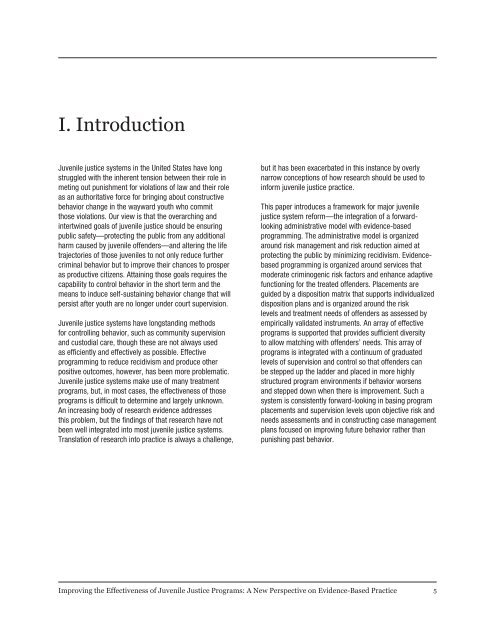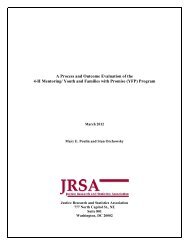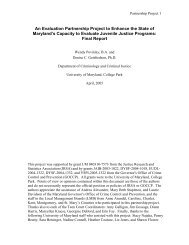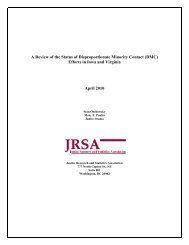Improving the Effectiveness of Juvenile Justice Programs: A New
Improving the Effectiveness of Juvenile Justice Programs: A New
Improving the Effectiveness of Juvenile Justice Programs: A New
Create successful ePaper yourself
Turn your PDF publications into a flip-book with our unique Google optimized e-Paper software.
I. Introduction<br />
<strong>Juvenile</strong> justice systems in <strong>the</strong> United States have long<br />
struggled with <strong>the</strong> inherent tension between <strong>the</strong>ir role in<br />
meting out punishment for violations <strong>of</strong> law and <strong>the</strong>ir role<br />
as an authoritative force for bringing about constructive<br />
behavior change in <strong>the</strong> wayward youth who commit<br />
those violations. Our view is that <strong>the</strong> overarching and<br />
intertwined goals <strong>of</strong> juvenile justice should be ensuring<br />
public safety—protecting <strong>the</strong> public from any additional<br />
harm caused by juvenile <strong>of</strong>fenders—and altering <strong>the</strong> life<br />
trajectories <strong>of</strong> those juveniles to not only reduce fur<strong>the</strong>r<br />
criminal behavior but to improve <strong>the</strong>ir chances to prosper<br />
as productive citizens. Attaining those goals requires <strong>the</strong><br />
capability to control behavior in <strong>the</strong> short term and <strong>the</strong><br />
means to induce self-sustaining behavior change that will<br />
persist after youth are no longer under court supervision.<br />
<strong>Juvenile</strong> justice systems have longstanding methods<br />
for controlling behavior, such as community supervision<br />
and custodial care, though <strong>the</strong>se are not always used<br />
as efficiently and effectively as possible. Effective<br />
programming to reduce recidivism and produce o<strong>the</strong>r<br />
positive outcomes, however, has been more problematic.<br />
<strong>Juvenile</strong> justice systems make use <strong>of</strong> many treatment<br />
programs, but, in most cases, <strong>the</strong> effectiveness <strong>of</strong> those<br />
programs is difficult to determine and largely unknown.<br />
An increasing body <strong>of</strong> research evidence addresses<br />
this problem, but <strong>the</strong> findings <strong>of</strong> that research have not<br />
been well integrated into most juvenile justice systems.<br />
Translation <strong>of</strong> research into practice is always a challenge,<br />
but it has been exacerbated in this instance by overly<br />
narrow conceptions <strong>of</strong> how research should be used to<br />
inform juvenile justice practice.<br />
This paper introduces a framework for major juvenile<br />
justice system reform—<strong>the</strong> integration <strong>of</strong> a forwardlooking<br />
administrative model with evidence-based<br />
programming. The administrative model is organized<br />
around risk management and risk reduction aimed at<br />
protecting <strong>the</strong> public by minimizing recidivism. Evidencebased<br />
programming is organized around services that<br />
moderate criminogenic risk factors and enhance adaptive<br />
functioning for <strong>the</strong> treated <strong>of</strong>fenders. Placements are<br />
guided by a disposition matrix that supports individualized<br />
disposition plans and is organized around <strong>the</strong> risk<br />
levels and treatment needs <strong>of</strong> <strong>of</strong>fenders as assessed by<br />
empirically validated instruments. An array <strong>of</strong> effective<br />
programs is supported that provides sufficient diversity<br />
to allow matching with <strong>of</strong>fenders’ needs. This array <strong>of</strong><br />
programs is integrated with a continuum <strong>of</strong> graduated<br />
levels <strong>of</strong> supervision and control so that <strong>of</strong>fenders can<br />
be stepped up <strong>the</strong> ladder and placed in more highly<br />
structured program environments if behavior worsens<br />
and stepped down when <strong>the</strong>re is improvement. Such a<br />
system is consistently forward-looking in basing program<br />
placements and supervision levels upon objective risk and<br />
needs assessments and in constructing case management<br />
plans focused on improving future behavior ra<strong>the</strong>r than<br />
punishing past behavior.<br />
<strong>Improving</strong> <strong>the</strong> <strong>Effectiveness</strong> <strong>of</strong> <strong>Juvenile</strong> <strong>Justice</strong> <strong>Programs</strong>: A <strong>New</strong> Perspective on Evidence-Based Practice<br />
5

















